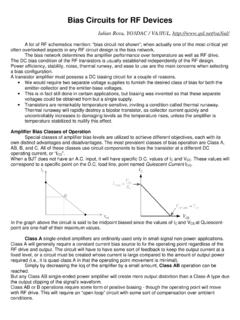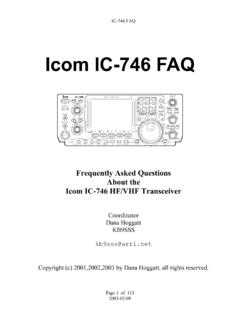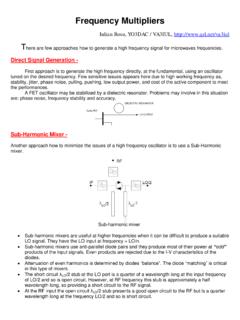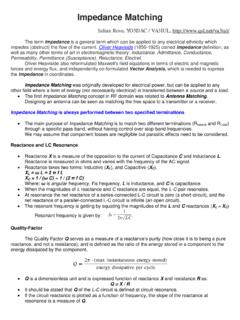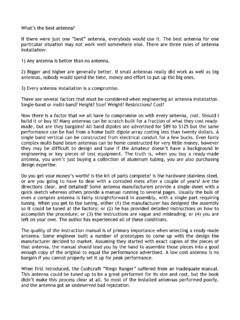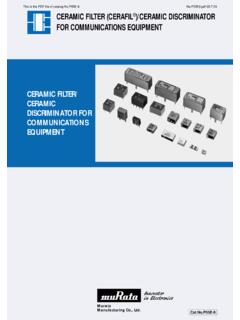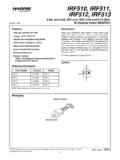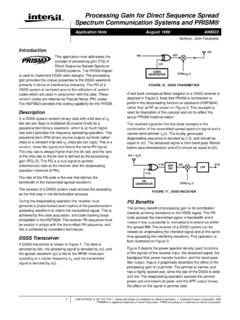Transcription of RF Power Amplifiers - QSL.net
1 RF Power Amplifiers Iulian Rosu, YO3 DAC / VA3 IUL, RF Power Amplifiers are used in a wide variety of applications including Wireless Communication, TV transmissions, Radar, and RF heating. The basic techniques for RF Power amplification can use classes as A, B, C, D, E, and F, for frequencies ranging from VLF (Very Low Frequency) through Microwave Frequencies. RF Output Power can range from a few mW to MW, depend by application. The introduction of solid-state RF Power devices brought the use of lower voltages, higher currents, and relatively low load resistances. Most important parameters that defines an RF Power Amplifier are: 1.
2 Output Power 2. Gain 3. Linearity 4. Stability 5. DC supply voltage 6. Efficiency 7. Ruggedness Choosing the bias points of an RF Power Amplifier can determine the level of performance ultimately possible with that PA. By comparing PA bias approaches, can evaluate the trade-offs for: Output Power , Efficiency, Linearity, or other parameters for different applications. The Power Class of the amplification determines the type of bias applied to an RF Power transistor. The Power Amplifier s Efficiency is a measure of its ability to convert the DC Power (Pdc) of the supply, into the signal Power delivered to the load (Po). The definition of the Efficiency ( ) can be represented in an equation form as: or Power Added Efficiency: Power that is not converted to useful signal is dissipated as heat.
3 Power Amplifiers that has low efficiency have high levels of heat dissipation, which could be a limiting factor in particular design. In addition to the class of operation, the overall efficiency of a Power Amplifier is affected by factors such as dielectric and conductor losses. First quantify any loss in the circuit, then attempt to minimize it, and finally ensure that the mechanical and thermal design is adequate under all conditions. The optimum load for highest Gain is determined by the small signal parameters of the device. The optimum load for minimum distortion and maximum output Power at the 1dB compression point (P1dB) is determined by the bias point and I-V characteristics of the device.
4 The load required to obtain the maximum value of Power Added Efficiency (PAE) will be some compromise between these two conditions. When considering which device will provide the greatest Power added efficiency at the 1 dB compression point, the answer will not necessarily be the device whose characteristics are more linear. It will be the device whose load requirements for gain and maximum value of the 1dB compression point are the most commensurate. Power Classes Class - A Is defined, as an amplifier that is biased so that the output current flows at all the time, and the input signal drive level is kept small enough to avoid driving the transistor in cut-off.
5 Another way of stating this is to say that the conduction angle of the transistor is 360 , meaning that the transistor conducts for the full cycle of the input signal. That makes Class-A the most linear of all amplifier types, where linearity means simply how closely the output signal of the amplifier resembles the input signal. Always have to remember this: No transistor is perfectly linear; however, the output signal of an amplifier is never an exact replica of the input signal. Linear amplification is required when the signal contains AM Amplitude Modulation or a combination of both, Amplitude and Phase Modulation (SSB, TV video carriers, QPSK, QAM, OFDM).
6 Signals such as CW, FM or PM have constant envelopes (amplitudes) and therefore do not require linear amplification. The DC- Power input is constant and the efficiency of an ideal Class-A PA is 50 % at PEP. The DC Power consumption of a Class-A amplifier is independent of the output signal amplitude. PDC = VCC2 / R = VCC x ICQ and ICQ ~ IMAX / 2 The amplification process in Class-A is inherently linear, hence increasing the quiescent current or decreasing the input signal level monotonically decreases IMD and harmonic levels. Since both positive and negative excursions of the drive affect the drain current, it has the highest gain of any PA.
7 The absence of harmonics in the amplification process, allows Class-A to be used at frequencies close to the maximum capability (fmax) of the transistor. However, the efficiency is low. Class-A Power Amplifiers are therefore typically used in applications requiring low Power , high linearity, high gain, broadband operation, or high-frequency operation. The efficiency of real Class-A Power Amplifier is degraded by the on-state resistance or saturation voltage of the transistor. It is also degraded by the presence of load reactance, which in essence requires the PA to generate more output voltage or current to deliver the same Power to the load. (Efficiency_Class-A) = Max_Load_Voltage / (2*Vcc2) One important thing to mentioned is that: small signal S-parameters can be used in simulations if the large-signal amplifier is operating in Class-A.
8 Class - B This is an amplifier in which the conduction angle for the transistor is approximately 180 . Thus, the transistor conducts only half of the time, either on positive or negative half cycle of the input signal. The same as in Class-A, the DC bias applied to the transistor determines the Class-B operation. Class-B Amplifiers are more efficient than Class-A Amplifiers . The instantaneous efficiency of a Class-B Power Amplifier varies with the output voltage and for an ideal PA reaches /4 ( %) at PEP. However, they are much less linear. Therefore, a typical Class-B amplifier will produce quite a bit harmonic distortion that must be filtered from the amplified signal.
9 PDC = (2*VCC*V) / ( *R) PLOAD = V2 / (2*R) (Efficiency_Class-B) = ( *V) / (4*VCC) Common configuration of Class-B amplifier is push-pull amplifier. In this configuration one transistor conducts during positive half cycles of the input signal and the second transistor conducts during the negative half cycle. In this way the entire input signal is reproduced at the output. A single transistor may be used in a Class-B configuration. The only requirement in this case is that a resonant circuit must be placed in the output network of the transistor in order to reproduce the other half of the input signal. In practice, the quiescent current is on the order of 10% of the peak collector current and adjusted to minimize crossover distortion caused by transistor nonlinearities at low outputs.
10 In theory 6dB or more drive Power is needed to achieve Class-B compared with Class-A. In practice this 6dB reduction in Power gain is lower; for BJT Amplifiers is lower than FETs, approximately 2dB. The efficiency of the push-pull Power amplifier is the same as that of the single ended Power amplifier with the same conduction angle, and the output Power capability of the push-pull Power amplifier is twice that of the single-ended Power amplifier (3dB higher). In the push-pull arrangement, the DC components and even harmonics cancel, but odd harmonics add, thus the output contains the fundamental only. Note that the cancellation of odd harmonics is only valid if the amplifier is not driven hard in saturation.
